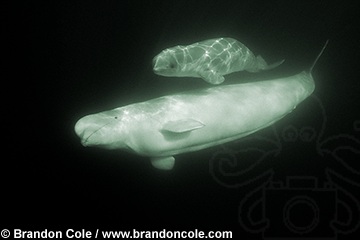|
photos of beluga
whales
To see more beluga whale
pictures, click here
|

photos of wild beluga whales Canadian
arctic |

belugas feeding at surface, photography
available for licensing |

tourists whale watching beluga whales of
Churchill Manitoba Hudson Bay |

underwater picture of mother and calf
Beluga Whale |
|
common
name |
Beluga
Whale |
| scientific
name |
Delphinapterus
leucas |
| range |
northern
polar waters- Arctic Ocean |
viewing
hotspots |
Churchhill,
Hudson Bay, Baffin Island, Gulf of St. Lawrence- all in Canada |
| habitat |
coastal,
open ocean, rivers |
| size |
to
16 feet (5m), 1.5 tons |
| diet |
squid, fish,
benthic invertebrates |
| trivia |
newborn calves
brown or gray; bulbous head's "melon" contains sophisticated
"sonar" echolocation system; unfused neck vertebrae allow it
to turn and nod its head |
|
Big attractions at marine
parks across North America, the beluga’s pearly white body hints
at its true home amidst the frigid waters of the ice-choked Arctic.
Small by whale standards- adult males measure up to 16 feet and
weigh in at 1.5 tons, with the females slightly smaller- the beluga
whale, Delphinapterus leucas, is very gregarious, usually traveling
with its brethren in groups of up to twenty. During summer months,
hundreds come together around river mouths to molt and nurse their
young. One of the most vocal of the toothed whales, belugas are
nicknamed "sea canaries" for their vast vocal vocabulary
of chirps, clicks, and whistles- a cheerful language of song
floating beneath the ice floes.
Some
scientists think the beluga may possess the most complex and
versatile sonar system of any cetacean, used not only to locate food
and fellow whales in the dark polar waters, but also for navigation
through a three dimensional world of drifting icebergs and
ever-changing channels. This animal is called belukha by the
Inuit tribes of Alaska, from the Russian meaning "white."
Its main natural predator is the polar bear. Though not considered
an endangered species, certain local stocks are under pressure from
human disturbances such as indigenous hunting and pollution. An
isolated population of some 300-500 belugas in Canada’s Gulf of
St. Lawrence have such high concentrations of chemical contaminants
in their tissues that they are treated as toxic waste when they die.
|
|
| KEYWORDS
beluga whale, beluga whales, beluga, belugas, belukha, white, whale, whales,
Delphinapterus leucas, cetacean, cetaceans, marine mammal, marine
mammals, monodontidae, toothed, underwater, whale-watching, eco-tourism,
feeding, photo, photos, photograph, photographs, picture, pictures, stock,
photography, marine |
|